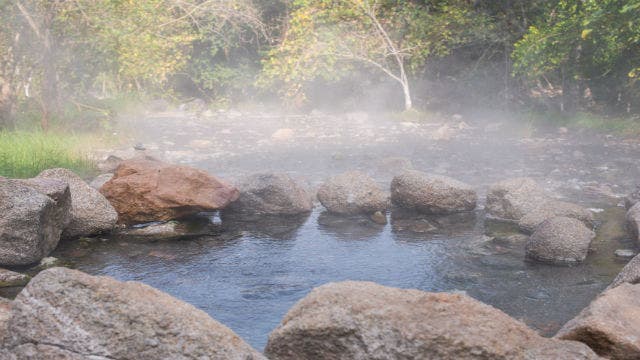Could a fountain of youth really exist?
Q&A with Dr. Manny: Are there any real health benefits to bathing in sulfur springs?
Sulfur is a naturally occurring mineral and soaking in sulfur springs water -- though it has an unpleasant smell of rancid eggs – can be traced back to ancient Egyptian and Roman times. Sulfur springs are located across the globe and have long been popular methods of early hydrotherapy. Here in the United States diverse places like Paso Robles, California, Hot Sulfur Springs, Colorado, Sulfur Springs, Texas, and at The Greenbrier in West Virginia, continue to allow people to succumb to a relaxing sulfur springs soak.
Though there are no conclusive medical studies in the U.S. regarding the benefits of soaking in sulfur water, studies in Japan, the Middle East and throughout Europe have shown that soaking in sulfur water can help kill germs and viruses in and on the skin including psoriasis, dermatitis, and fungal infections. Known as balneotherapy -- the term ‘balneo’ comes from the Latin word for bath and means soaking in thermal/mineral waters -- or medical hydrology, it is considered a medical science outside of North America and is an integrated part of allopathic medical practices and preventative medicine. In some places, like France, partial costs of medical hydrology are even covered by their healthcare system.
The U.S. has been slower to respond to medical hydrology and though the Balneotherapy Association of North America provides some comprehensive information about the positive effects, it needs to be noted that the American Medical Association does not recognize this kind of treatment. However, the University of Maryland Medical Center states, “well-designed studies, most conducted in Israel, suggest that balneotherapy can help treat several different kinds of arthritis, including osteoarthritis, rheumatoid arthritis, and psoriatic arthritis. People who took sulfur baths and other spa therapies improved strength, had less morning stiffness, had better walking ability, and less inflammation, swelling, and pain in joints, particularly in the neck and back.” These water treatments can also include mud baths containing sulfur. The University of Maryland Medical Center also states, “Some people claim these baths are useful for allergies and respiratory problems, but there is no scientific evidence for these uses.”
The interest in non-pharmacological and alternative methods of treatments is growing. There is a desire for non-invasive and natural ways to treat certain medical issues and sulfur springs can be a compliment to your regimen with less cost than medications. It’s also important to note that soaking in water, sulfur or otherwise, increases hydrostatic pressure on the body – the compacted pressure you feel when underwater -- which promotes blood circulation and can improve nourishment to your vital organs. A soak can also aid with removing toxins from our bodies, similar to soaking in your bathtub using Epsom salts.
What you don’t want to do is drink sulfur water. According to The Environmental Protection Agency (EPA) and the Centers for Disease Control and Prevention (CDC), drinking water with high levels of sulfate can cause diarrhea, especially in infants. Using a hot tub or natural sulfur spring is also not recommended for pregnant women, individuals with high blood pressure and people on blood thinning medications. Sulfur by itself is not toxic to our bodies. Low doses of sulfur are found in eggs and chicken. However, some people are allergic to sulfites and sulfa drugs so you should contact your health care provider before soaking in sulfur water if you think you may be allergic to any sulfur-containing substances.
Lastly, even if a sulfur soak does not provide relief for you in the ways mentioned above, any time we can relax our bodies we are reducing our physical and emotional stress load and promoting our sense of wellbeing. So take that soak- assuming you can handle the smell.
Michael Cervin is a water writer, senior editor at BottledWaterWeb.com, and author of the forthcoming book, “Our World of Water: The Good, The Bad, and The Ugly of Earth’s Most Critical Resource.” Learn more about Michael at thisworldofwater.blogspot.com.

